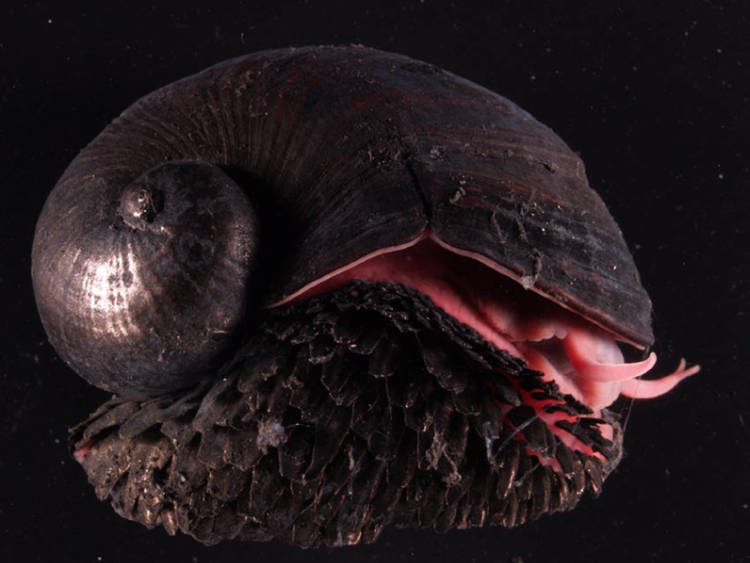Crysomallon squamiferum, commonly known as scaly foot gastropod is a fascinating sea snail that inhabits one of the most inhospitable environments on the planet and has evolved a natural iron armor in order to do so.
“Scaly foot gastropod” has to be one of the most boring names ever picked for one of the coolest creatures on Earth – a sea snail living 2.78 kilometers (1.7 miles) underneath the surface of the Indian Ocean, around hydrothermal vents are spewing out water around 350°C (660°F). Not to mention that this badass snail is the only known creature to have developed a natural metallic armor that is unlike any other known natural or synthetically engineered armor. Did I mention that it doesn’t even need to eat, as a bacteria in its gut produces all the nutrients it needs to survive? Surely such a creature deserved a cooler name…

Photo: 10.1371/journal.pone.0032965
Discovered in 1999, Crysomallon squamiferum has been a source of wonder for marine life researchers ever since, because of its ability to thrive in a hostile environment, but more so because of its unique armor. The snail’s shell has three layers: a highly calcified inner layer, a thick organic middle layer, and an outer layer that is fused with granular iron sulfide, making it considerably tougher than the shells of most gastropods.
Then there is the scalemail-like armor covering the snail’s otherwise squishy foot. They are made of iron sulfides (pyrite and greigite) and provide excellent protection against the predators known to live in the same environment – cone snails, which penetrate their victims with a needle-sharp tooth before paralyzing them with a potent venom, and sea-faring crabs, which use their strong vice-like claws to squeeze their prey.
The mechanism in which the scaly foot gastropod develops its metallic armor is yet unknown, but some researchers hypothesize that bacteria living on the surface of the snail, which metabolize the noxious sulfides ejected from hydrothermal vents, may be responsible for this natural wonder.
Another fascinating trait of these armored snails is their size, comparable to that of common garden snails. It’s surprisingly large for the environment it inhabits, three times the size of other known deep sea, especially since they get life-sustaining energy through a process called chemosynthesis (bacteria in their guts produce all the nutrients they need).
Sadly, despite the apparent toughness of this armored snail, we have managed to put it on the endangered creatures list, due to deep-sea mining. And experts warn that because of the specific conditions of its environment, we will not be able to breed them artificially.
“These are fragile areas under threat, and it’s not like we researchers can start a breeding program for deep-sea-vent creatures, we can only try to protect what’s there,” Julia Sigwart, a deep-sea biologist at Queen’s University Belfast, told Nature.






